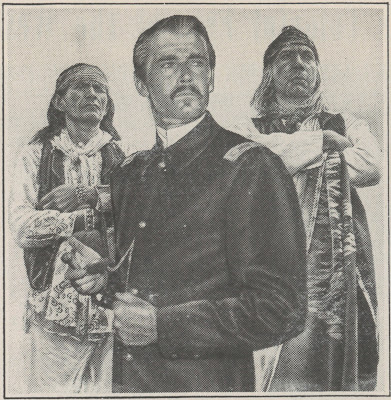Western locations have suddenly become something I notice. Part of that comes of reading about places like Lone Pine and Corriganville on line and in pages of Western Clippings. There's a yearly festival at Lone Pine, that rock formation horn of plenty over which horse and rider by thousands chased and show-downed against majestic backgrounds. Fans go there because these are actual and largely unchanged sites still host to cowboy spirits who rode but will no more. John Wayne and Gene Autry may be gone, but Lone Pine is forever. They'll not be striking these sets. Trips to Lone Pine amount to pilgrimage for fans who've committed environs to memory. They'll tell you which boulder appeared in what Hoppy, identify a mountain far distant and spell out how many features that peak backgrounded. It matters for me now where screen cowboys rode just as it always did among seasoned watchers. Why did I take so long appreciating nature's role in making these shows great?
 |
| John Wayne Waits Out Crew Preparation for a Next Fort Apache Scene. |
I've known some who trekked to
Lone Pine's festival has yielded printed annuals (two I've found on Amazon --- are there more?) with terrific articles about westerns shot there. Genre experts Richard Bann and Ed Hulse are among contributors. Ed's appreciation of lost-till-now Republic serial (and largely LP-shot) Daredevils Of The West inspired me to order the DVD from Serial Squadron. I'll not be writing about it here because he's covered the topic definitively, as has Bann on 1935's Westward Ho!, John Wayne's first for newly organized Republic Pictures, and happily streaming on Netflix, so I was able to read, then watch.
There's nothing of the
The
It's looseness and meandering I like best in Ford's cavalry. Once you're told Bravo and Ambush's story, the party's over.
Ambush and Escape From Fort Bravo reflect well rules others played by. What these two do best is take us far afield of studio ranches and too-familiar brush. Ambush was filmed around Gallup and
Lowered expectations are best company to Ambush and
 |
| Much arrow extraction in evidence throughout cavalry pics that flourished during the fifties. |
Escape From Fort Bravo is a 1954 MGM release unfortunately shot with Anscocolor. The process represented an economy measure. Ansco never looked very good, and otherwise satisfactory films like this and Seven Brides For Seven Brothers suffered for its being utilized. As with Ambush, there was location work at












